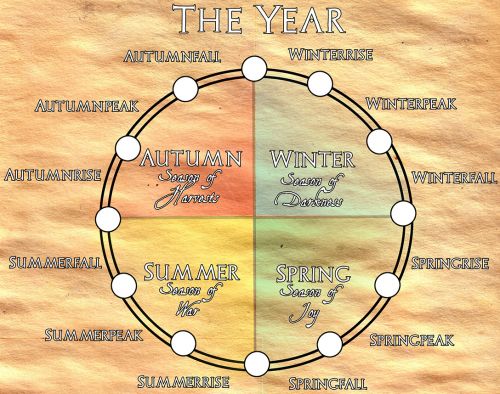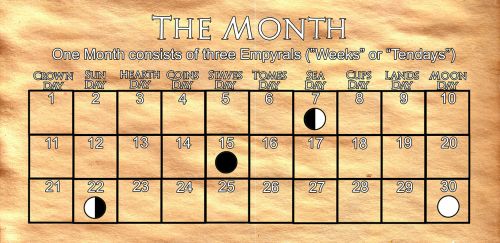Difference between revisions of "Calendar of Liminal"
| Line 30: | Line 30: | ||
==The Weeks== | ==The Weeks== | ||
| − | [[Image:Liminal-calendar-weeks.jpg| | + | [[Image:Liminal-calendar-weeks.jpg|center|500px]] |
There are ten days to a week, or an "empyral," as they are known, for there is one day of the week for each of the Empyrean gods. It is customary for worshippers of these gods to stop by a temple or otherwise dedicate some time to their worship on the day of the week that is sacred to their deity. | There are ten days to a week, or an "empyral," as they are known, for there is one day of the week for each of the Empyrean gods. It is customary for worshippers of these gods to stop by a temple or otherwise dedicate some time to their worship on the day of the week that is sacred to their deity. | ||
Latest revision as of 12:58, 17 April 2015
The Years
x
The Months
The months are named for the season they embody, and the part of that season: "-rise" denotes the first month of that season, "-peak" the second month, and "-fall" the third and last month. Though not many folk know this, the months of the year are aligned with the Starry Wisdoms that are ascendant in that month. The Rising Months are associated with the Wisdoms of Destiny, the Peaking Months are associated with the Wisdoms of Fortune, and the Falling Months are associated with Wisdoms of Fate. Each month lasts three weeks.
Winter
The Season of Darkness
- Winterise: The first month of winter. There is some degree of dread that comes with the snows, for there is never any telling who will or will not survive the winter. Those who are often ill or simply weak pass in this month. Those born at this time of the year are considered touched by death, for their first breath is of the winter's cold, and there is never any guarantee the child will survive the month. (Light of Winter)
- Winterpeak: The middle month of winter. By this time, folk have settled into their winter routines, and often work on the things that inspire them or allow them to practice their creativity. Those born during this time of the year are often considered very creative and blessed if they can survive the winter. (Sage of Fools)
- Festival of Lights (Last Hearthday of Winterpeak): Communities across Rinhony gather up last year's old used candles or make new ones of cast-offs. Families hang lanterns in every window and on great strings across walkways. This is intended to bring joy to the people, reminding them of the light of the rest of the year, and encouraging those whose spirits are flagging in the winter's oppression to bear up, for the winter is nearly done. Since so many folk work on their own creative endeavors during this month, many folk have started giving gifts at this time of year as well.
- Winterfall: The last month of winter. It is during this time of year that the first thaw generally comes, signalling the return of winter. This is the time of year when most ewes are nearest to lambing. Those born during this time of the year are sometimes considered "lamb-like" in their minds, characterized as being somewhat simple in thought and deed. Those who are not, however, are often clearly "old souls," with more wisdom than their age should allow. (Senescence of the Void)
- The Holly Rites (First Thaw of Winterfall): With the first thaw, communities gather the remains of those who passed during the winter. Because there are no flowers or other plants of color during this time save the vibrance of the holly, these tombs are laid with wreaths of holly. The digging of the graves is performed by all of those with the strength to work at the toil in the community, and the others provide them with hot spiced ciders to warm their work.
Spring
The Season of Joy
- Springrise: This is the first month of spring, after the ground and water has thawed. The first buds are often starting to shoot out, and the days become warmer and longer. Rain (albeit quite chilly) replaces snow in the sky, and the land begins to waken to life. (Flower of Humility)
- The Festival of the Fields (After Fields are Plowed): In preparation for planting, once the fields have been plowed, there is a customary "feeding of the fields." Songs are sung comparing the newly opened furrows to the hungry mouth of a child, and the people wander its length, dropping in bits of bread made from the grains grown there last year, and small tankards of milk into the ground.
- Springpeak: Spring has come fully into season, and the rains begin to warm some. Most of the trees are fully leaved, and the grass has begun to sprout as well. Flowers cover the hillsides, and the weather begins to warm. (Crown of Joy)
- Motherstide (First Hearthday or Landsday after Sowing): A celebration dedicated to the Two Mothers, and to mothers in general, it is a three day festival, usually on the Hearthday or Landsday that comes right after the fields have been sown. A parade made up of the community's mothers process through the fields, encouraging them to grow and "showing" the land how to "be a mother" by their example. It is not uncommon for couples looking to have a child to sneak out to the fields after dark with a blanket to try and conceive.
- Springfall: x (Death of Wisdom)
Summer
The Season of War
- Summerrise: x (Effulgence of Illumination)
- Summerpeak: x (Raucous Benediction)
- Summerfall: x (Imperious Gatherer)
Autumn
The Season of Harvests
- Autumnrise: Harvest of the Fields. (Listener of Winds)
- Autumnpeak: Harvest of the Orchards. (Pearl Savant)
- Autumnfall: Harvest of the Herds. (Intellect of the Vault)
The Weeks
There are ten days to a week, or an "empyral," as they are known, for there is one day of the week for each of the Empyrean gods. It is customary for worshippers of these gods to stop by a temple or otherwise dedicate some time to their worship on the day of the week that is sacred to their deity.
These days are:

